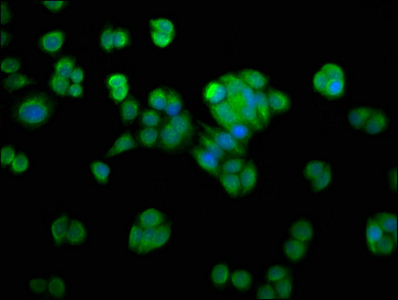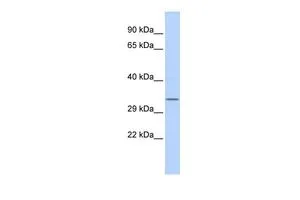
Immunofluorescence staining of PC-3 cells with CSB-PA867194LA01HU at 1:200, counter-stained with DAPI. The cells were fixed in 4% formaldehyde, permeabilized using 0.2% Triton X-100 and blocked in 10% normal Goat Serum. The cells were then incubated with the antibody overnight at 4°C. The secondary antibody was Alexa Fluor 488-congugated AffiniPure Goat Anti-Rabbit IgG(H+L).
NMRAL1 Antibody
CSB-PA867194LA01HU
ApplicationsImmunoFluorescence, ELISA
Product group Antibodies
ReactivityHuman
TargetNMRAL1
Overview
- SupplierCusabio
- Product NameNMRAL1 Antibody
- Delivery Days Customer20
- ApplicationsImmunoFluorescence, ELISA
- CertificationResearch Use Only
- ClonalityPolyclonal
- ConjugateUnconjugated
- Gene ID57407
- Target nameNMRAL1
- Target descriptionNmrA like redox sensor 1
- Target synonymsHSCARG, SDR48A1, nmrA-like family domain-containing protein 1, NmrA-like family domain containing 1, epididymis secretory sperm binding protein, short chain dehydrogenase/reductase family 48A, member 1
- HostRabbit
- IsotypeIgG
- Protein IDQ9HBL8
- Protein NameNmrA-like family domain-containing protein 1
- Scientific DescriptionRedox sensor protein. Undergoes restructuring and subcellular redistribution in response to changes in intracellular NADPH/NADP(+) levels. At low NADPH concentrations the protein is found mainly as a monomer, and binds argininosuccinate synthase (ASS1), the enzyme involved in nitric oxide synthesis. Association with ASS1 impairs its activity and reduces the production of nitric oxide, which subsecuently prevents apoptosis. Under normal NADPH concentrations, the protein is found as a dimer and hides the binding site for ASS1. The homodimer binds one molecule of NADPH. Has higher affinity for NADPH than for NADP(+). Binding to NADPH is necessary to form a stable dimer.
- ReactivityHuman
- Storage Instruction-20°C or -80°C
- UNSPSC41116161



